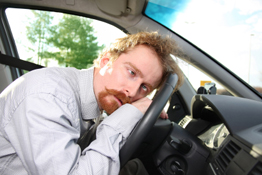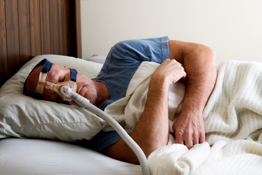Sleep Apnea
Over 70 million Americans suffer from a sleep disorder. You don't have to be one of them. Come talk to us today.

Sleep Apnea
Sleep apnea is quite common but most people who have sleep apnea don’t know they have it until someone else witnesses it and tells them. Sleep apnea causes a person to take shallow breaths or even pause while breathing during sleep. The breathing pauses can last only a few seconds but can go on for minutes.
Sleep apnea patients usually snore and they sometimes make a loud snort sound during the episode. They often suffer from daytime sleepiness because their sleep is interrupted even if the snoring and the breathing pauses don’t actually wake them up.
The most common type of sleep apnea is obstructive sleep apnea. In this condition, the airway collapses or becomes blocked during sleep. This causes shallow breathing or breathing pauses.
Obstructive sleep apnea (OSA) is more common in people who are overweight, but it can affect anyone. For example, small children who have enlarged tonsils may have obstructive sleep apnea.
Sign and Symptoms
Adults
Daytime sleepiness and fatigue
Snoring
Morning headaches
Insomnia due to waking often or difficulty maintaining sleep
Trouble concentrating
Mood changes such as irritability, anxiety and depression
Forgetfulness
Increased heart rate and/or blood pressure
Decreased sex drive
Unexplained weight gain
Increased urination
Frequent heartburn or acid reflux disease
Heavy night sweats
Children
Over-tired or hyperactive
Poor growth
Learning and memory deficits
Risk Factors
Old age
Alcoholic drinks
Gender: men are more susceptible
Family history
Smoking
Diagnosis
A sleep specialist will use a physical exam, your medical history, your family medical history, and most likely a sleep study to diagnose sleep apnea. He or she will want to know as much about your pattern of snoring and breathing during sleep as possible, information most patients need to get from a spouse or partner. Parents should come prepared to talk about the child’s sleeping patterns.
Physical Exam
Your doctor will check your mouth, nose, and throat for extra or large tissues that might be blocking the path of air. Children who have sleep apnea might have enlarged tonsils. Doctors may need only a physical exam and medical history to diagnose sleep apnea in children.
Sleep Studies
Sleep studies are tests that measure how well you sleep and how your body responds to sleep problems. These tests can help your doctor find out whether you have a sleep disorder and how severe it is. Sleep studies are the most accurate tests for diagnosing sleep apnea.
A sleep study is painless. The patient is connected to light-weight, non-obstructive testing equipment and simply goes to sleep in a comfortable, carefully designed bedroom at the sleep clinic.
The study records brain activity, eye movements, heart rate, and blood pressure. It also records the amount of oxygen in your blood, air movement through your nose while you breathe, your snoring and your chest movements. The chest movements show whether you’re making extra effort to breathe.
Your sleep specialist will review the results of your study to see whether you have sleep apnea and how severe it is. He or she will use the results to plan your treatment.
Your doctor also may use a sleep study to find the best setting for you on a CPAP (Continuous Positive Airway Pressure) machine.
Treatment
Treatment is important to restore regular breathing during sleep and to relieve the bothersome symptoms such as snoring and daytime sleepiness. Treatment may also improve other medical problems linked to sleep apnea, such as high blood pressure, and it can reduce your risk for heart disease, stroke, diabetes and mood disorders.
There are a variety of treatments for OSA. A sleep specialist will decide which treatments are appropriate based on the patient’s medical history, the severity of the disorder and, most importantly, the specific cause of the obstruction. Treatments include lifestyle changes, mouthpieces, breathing devices, and surgery. Medicines typically aren’t used to treat sleep apnea.
Lifestyle Changes
Avoid alcohol and medicines that make you sleepy.
Lose weight if you’re overweight or obese.
Sleep on your side instead of your back to help keep your throat open.
If you smoke, quit.

Breathing Devices
CPAP (continuous positive airway pressure) is the most effective treatment. A CPAP machine uses a mask that fits over your nose or over your mouth and nose.
The machine gently blows air into your throat. The pressure from the air helps keep your airway open while you sleep so it eliminates the breathing pauses and snoring.
A technician will set up the CPAP machine and adjust it based on your doctor’s prescription. He or she will teach you what you need to know to use the CPAP equipment with confidence. After the initial setup, you may need to have the CPAP adjusted from time to time for the best results.
People who have severe sleep apnea symptoms generally feel much better once they begin treatment with CPAP.
Mouthpieces
A mouthpiece, sometimes called an oral appliance, is recommended in patients with mild to moderate sleep apnea who cannot tolerate CPAP. Your doctor also may recommend a mouthpiece if you snore loudly but don’t have sleep apnea.
A dentist trained in dental sleep medicine can custom fit you with an oral appliance. The mouthpiece will adjust your lower jaw and your tongue to help keep your airways open while you sleep.
Surgery
Some people who have sleep apnea and are not able to tolerate the CPAP might benefit from surgery. The sleep physician who diagnoses your sleep apnea can refer you to an ear, nose and throat surgeon who will perform the procedure.
Surgery is done to widen breathing passages. It usually involves shrinking, stiffening, or removing excess tissue in the mouth and throat or resetting the lower jaw.
OSA in children is sometimes due to chronically enlarged tonsils and adenoids. Removing them surgically is a smart option for some patients. Your sleep specialist can advise you on this.
